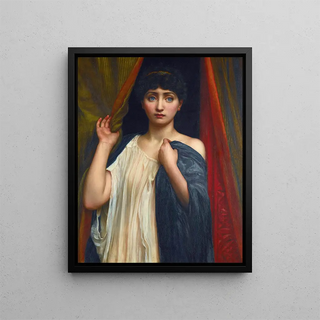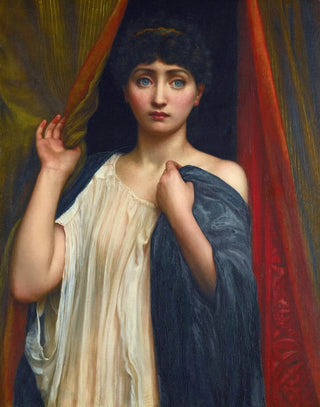Painting Cressida - Edward John Poynter | Art print


View from behind

Frame (optional)
In the vast panorama of art history, certain works stand out for their ability to capture the collective imagination. "Cressida" by Edward John Poynter is one of those creations that, through its elegance and narrative depth, transports the viewer into a world where beauty and tragedy intertwine. Inspired by the figure of Cressida, a tragic character from Shakespearean literature, this piece invites reflection on love, loyalty, and loss. Poynter, through his mastery of colors and textures, manages to bring this heroine to life, making her emotional dilemma palpable. The art print Cressida - Edward John Poynter thus allows access to this unique aesthetic experience, where each glance reveals a new facet of human complexity.
Style and uniqueness of the work
Edward John Poynter's style is characterized by striking realism and meticulous attention to detail. In "Cressida," the artist uses a delicate color palette, blending warm and cool tones to create an atmosphere that is both intimate and melancholic. The lighting, skillfully orchestrated, highlights Cressida's delicate features, emphasizing her troubled expression. The composition of the piece is also remarkable, with elements that come together to form a coherent visual narrative. The drapes of her dress, adorned with floral motifs, seem almost to come alive, adding a dynamic dimension to the scene. Poynter thus manages to transcend simple representation to offer a true immersion into the emotional universe of his subject.
The artist and his influence
Edward John Poynter, an emblematic figure of the Pre-Raphaelite movement, knew how to mark his era with his innovative approach to painting. Born in 1836, he was influenced by the great masters of the Renaissance, but also by the romantic ideals of his time. His ability to fuse realism with poetic sensitivity allowed him to stand out in the Victorian art world. Poynter not only left an indelible mark on his contemporaries but also inspired many generations of artists.

Matte finish

View from behind

Frame (optional)
In the vast panorama of art history, certain works stand out for their ability to capture the collective imagination. "Cressida" by Edward John Poynter is one of those creations that, through its elegance and narrative depth, transports the viewer into a world where beauty and tragedy intertwine. Inspired by the figure of Cressida, a tragic character from Shakespearean literature, this piece invites reflection on love, loyalty, and loss. Poynter, through his mastery of colors and textures, manages to bring this heroine to life, making her emotional dilemma palpable. The art print Cressida - Edward John Poynter thus allows access to this unique aesthetic experience, where each glance reveals a new facet of human complexity.
Style and uniqueness of the work
Edward John Poynter's style is characterized by striking realism and meticulous attention to detail. In "Cressida," the artist uses a delicate color palette, blending warm and cool tones to create an atmosphere that is both intimate and melancholic. The lighting, skillfully orchestrated, highlights Cressida's delicate features, emphasizing her troubled expression. The composition of the piece is also remarkable, with elements that come together to form a coherent visual narrative. The drapes of her dress, adorned with floral motifs, seem almost to come alive, adding a dynamic dimension to the scene. Poynter thus manages to transcend simple representation to offer a true immersion into the emotional universe of his subject.
The artist and his influence
Edward John Poynter, an emblematic figure of the Pre-Raphaelite movement, knew how to mark his era with his innovative approach to painting. Born in 1836, he was influenced by the great masters of the Renaissance, but also by the romantic ideals of his time. His ability to fuse realism with poetic sensitivity allowed him to stand out in the Victorian art world. Poynter not only left an indelible mark on his contemporaries but also inspired many generations of artists.






